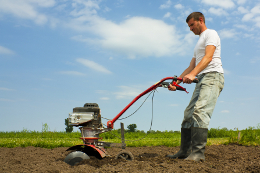
FESCUE GRASS SEED GUIDE
Fescue grass can be categorized into two main types: tall fescue and fine fescue. Both types share some common attributes.
Known for its unique blades and growing patterns, fescue is a perennial grass that does well in the mid to northern regions of the United States. This grass species thrives best in shady lawns and cool temperatures; it's even considered one of the best grass seeds for poor soil! It’s perfect for all-season homeowners who crave a durable lawn that retains its color throughout the year.How to Plant Fescue Grass Seed
When planting fescue, you’ll first have to start with a clean slate. This means eliminating any existing weeds and potentially cultivating the soil with great fertilization.
Once your lawn is cleaned up, you’ll take a small hand rake to rake the area for a smooth surface carefully. Then you can begin evenly placing seeds throughout the area, where you’ll need about 8 pounds per 1,000 square feet. It’s okay to overlap seeds in the same areas, but be sure that it’s evenly distributed throughout the lawn to avoid clumping. Most people opt for a manual tilling machine, which you can rent or buy at most local hardware or gardening stores.
When you’ve finished seeding, use your rake to go over the seeds, ensuring that they’re ¼ of an inch deep into the soil. Upon completion, water the area so that germination can begin.
Quick tip: Because fescue is a clump-forming grass, you’ll want to spread mulch or wheat straw over the final area. This type of coverage will help the soil retain moisture and avoid unwanted erosion.
When to Plant Fescue Grass
Fescues are a cool-season grass, so it’s best to plant its seed in early fall between mid-August and mid-October when outdoor temperatures average around 70° to 75°F. This way, the young seeds will experience less heat, stress, and disease.
If you miss this window to plant, then you still have a chance to without waiting for the next fall season. You can try again when temperatures begin to rise in spring and reach around 60°F. Mid-spring is a great time because it’s still chilly enough outside so that the seeds can comfortably germinate and develop strong resistance once summer arrives.
Quick tip: Always avoid planting in the summer or winter months. Young fescue will go dormant in temperatures below 50°F and above 90°F.
How to Grow Fescue Grass
Although an excellent turf grass, fescue is infamously known to be a “bunching-type grass,” meaning that this blend tends to grow in random clumps. This is partly due to the fact that fescues also don’t creep as other turf grasses do—so without proper planting, it’s easy for these lawns to look uneven and dispersed.
Fescue grass is a popular cool-season grass that does best in part sun to fully shaded lawns. Its finely-textured, dark green blades germinate surprisingly quickly in even poor or difficult soils thanks to its deep roots. This drought-resistant blend only requires 1 to 1 ¾ inch of water each week.
While fescues do well throughout the middle belt and northern regions of the U.S., it will go dormant in the full sun, especially during the summer months. If you do decide to plant fescue on a sunny lawn, you’ll need to water it more often to avoid dormancy.
Finding the Right Seed For Your Project
Everybody wants a beautiful lawn, but it can be a challenge to find a blend that’s perfect for your all-season home. The good news is that it’s never been easier to find a perfect grass seed: Nature’s Seed has several combinations of high-quality fescues designed to thrive throughout the mid and northern regions. Find the perfect blend for your project today!
